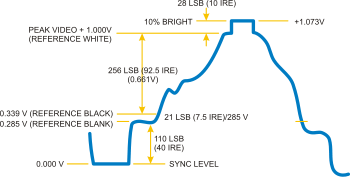PConst167
Member
Hi friends,
I have finished working on a simple video card that generates sync pulses for PAL/CCIR monochrome televisions. Apparently I have gotten the TV to sync to my signals, however, I was hoping to be able to control the brightness of the screen with my circuit in order to confirm that the TV was really obeying the circuit. Here's the problem! The TV only shows a white screen. I don't know how to manipulate the voltage in order to lower it and match the TV's requirements.
My signals stay constant at around 4.5V, and then at sync times they go to 0V. What should I do to them to be able to fit them to the TV's requirements for composite PAL?
Some sources say the sync pulses are -0.3V rather than 0V. Some say it's 0V. I tried inverting the signals to see what happens and what I see on the TV are lots of little horizontal white lines in a black screen, and a thick white line at the bottom. Since this is the inverted signal, does this mean that the original signal is correct? Since if the inverted one was correct, it wouldnt show the white lines everywhere.
I appreciate your help.
Paul
I have finished working on a simple video card that generates sync pulses for PAL/CCIR monochrome televisions. Apparently I have gotten the TV to sync to my signals, however, I was hoping to be able to control the brightness of the screen with my circuit in order to confirm that the TV was really obeying the circuit. Here's the problem! The TV only shows a white screen. I don't know how to manipulate the voltage in order to lower it and match the TV's requirements.
My signals stay constant at around 4.5V, and then at sync times they go to 0V. What should I do to them to be able to fit them to the TV's requirements for composite PAL?
Some sources say the sync pulses are -0.3V rather than 0V. Some say it's 0V. I tried inverting the signals to see what happens and what I see on the TV are lots of little horizontal white lines in a black screen, and a thick white line at the bottom. Since this is the inverted signal, does this mean that the original signal is correct? Since if the inverted one was correct, it wouldnt show the white lines everywhere.
I appreciate your help.
Paul

